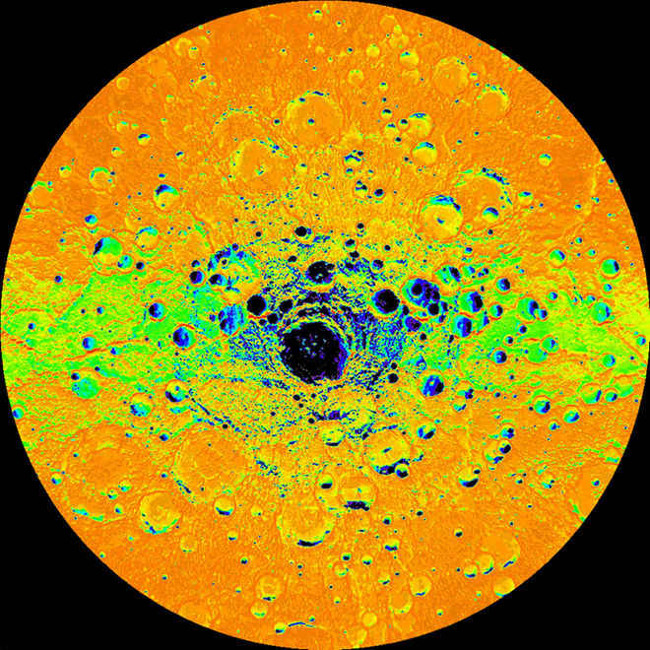How hot is the planet of Mercury?
Mercury or Glass is the smallest planet and closest to the Sun in the 8 planets of the solar system. Although Mercury's surface holds the most different temperature difference in the solar system, Glass is not the hottest planet. The temperature on Venus's surface is much hotter than the temperature on Mercury's surface, although the distance from the Sun to Venus is twice as far from the Sun to Mercury's planet. Why is this and how hot the planet of Mercury is?
 Mercury's southernmost image from NASA's Messenger probe offers a color map based on the basic percentage of a specific area with sunlight, areas that appear in blue in the map are permanently dark areas.Image source: NASA / Johns Hopkins University Applied / Carnegie Institution of Washington Laboratory
Mercury's southernmost image from NASA's Messenger probe offers a color map based on the basic percentage of a specific area with sunlight, areas that appear in blue in the map are permanently dark areas.Image source: NASA / Johns Hopkins University Applied / Carnegie Institution of Washington Laboratory
High temperature and low temperature
With an orbit of 46 to 70 million kilometers ( 28 to 43 million miles ) from the Sun, Mercury is the smallest planet but is most affected by the rays of the Sun. According to NASA, this tiny planet is within the harshest temperature range compared to other planets in the solar system. The daytime face of the planet is subjected to temperatures up to 427 degrees Celsius ( 800 degrees F ). In contrast, the cold night face has a negative temperature of around 180 degrees Celsius ( minus 290 degrees F ). The average temperature of Mercury is 167 degrees C ( 332 degrees F ).
Scientists once thought that Mercury had only one face facing the Sun, in the case known as tidal locking . Because the planet Mercury is very close to the Sun, it is studied when there is a rocky, rugged, rugged surface facing the Earth at different points in orbit. However, more in-depth studies have further revealed that the planet rotates very slowly - spinning around its axis is made three times in two orbital cycles around the Sun, when it is taking fixed stars as a frame of reference. If viewed from the Sun, in the frame of rotation in orbit, Mercury only rotates one cycle in the two orbits of the planet.
During the one-day period of the day, the Sun moves very slowly from the eastern horizon to the western horizon, while the planet Mercury has completed an orbit around the Sun, passing through both the perihelion and the point. Farewell. At the near-Japanese point, the intensity of light shining on the surface of Mercury's planet is twice as high when it is at a frenzy. There are points on the surface at the near-point where the Sun shines continuously during the "day", so these places become very hot.
According to Mercury's changing speed of sky movement, the difference between the near-and-near-day temperature increases. Mercury has a higher orbital velocity when it reaches the point of near-sightedness and near the near-Japanese point. At this time, if we look from the Sun, we will only see one face of Mercury hemisphere always facing the Sun, similar to a hemisphere. The longer a hemisphere directs to the Sun, the more the solar radiation is projected on this hemisphere during a time near the perihelion.
With so little mass, Mercury is unable to preserve its atmosphere - atoms in the atmosphere are constantly lost into space because the gravity of gravity is too weak. Moreover, Mercury is closest to the Sun, so it is a hot planet and has the thinnest atmosphere. The atmosphere helps " cover " a planet, keeping heat from leaking into space. Without an atmosphere or atmosphere too thin, Mercury will lose a lot of heat into the space, instead of sharing the temperature with the night.
But unexpectedly, the hottest planet is Venus - the second planet from the Sun. Because Venus has a thick atmosphere that covers the planet, it keeps its temperature at an average of 462 degrees C (864 degrees F). There is a thick layer of CO2 on Venus, allowing light to pass through but keeping heat on the surface. Therefore, although the heat received from Venus is less than Mercury, the thick atmosphere helps Venus to retain more temperature. As a result, the temperature on Venus's surface is about 427 degrees Celsius (700 degrees K), while the temperature on Mercury is only 167 degrees Celsius (440 degrees K).
Location
On our planet Earth, the temperature changes with the season due to the tilt of the planetary axis. If the Southern Hemisphere is closer to the Sun than the Northern Hemisphere, spring and summer will be replaced by autumn and winter. But basically, the planet Mercury is not inclined, meaning that the hemisphere has no significant difference in temperature.
That allows Mercury, the planet closest to the Sun, to hold ice on its surface. Parts of the two poles never see sunlight, leading to the leading scientists theorizing that ice (water) can exist on the planet Mercury. Observations from Earth in 1991 identified unusual light trails corresponding to dents illuminated by Mariner 10 in the 1970s. When NASA's MESSENGER spacecraft researched the north pole in 2011, it confirmed that the radar light characteristics at the two poles match the dark areas. In 2012, the MESSENGER spacecraft used a technique called neutron spectroscopy to measure average hydrogen concentrations in light radar areas, adding evidence to water.
On November 29, 2012, NASA announced the confirmation of images taken from the space of the MESSENGER spacecraft that detected collisions in the north pole containing water ice.
" The neutron data indicate that on average, objects deposited on Mercury's light radar contain a hydrogen-rich layer tens of centimeters thick under a layer of 10 to 20cm thick surface with less hydrogen, " the scientist said. MESSENGER - David Lawrence at the Applied Physics Laboratory at Johns Hopkins University said, " The lower floors have a
Hydrogen content is suitable for almost pure water ice ".
 Mercury orbit and Earth's orbit around the Sun.Photo source: Wiki
Mercury orbit and Earth's orbit around the Sun.Photo source: Wiki
After the discovery, NASA's MESSENGER spacecraft continued to study polar ice mines through its extensive mission. By refining the images, the MESSENGER spacecraft captures deposited objects on the surface.
" Learning a lot of things when observing settling objects" Nancy Chabot, MESSENGER 's Mercury Dual Instrument System scientist , said in a statement.
However, Mercury's orbit is the most narrow and strangely elliptical of all the planets in the solar system. Mercury's orbital velocity is very large because of the Sun's gravitational influence - rotating a circle around the Sun for about 88 days - a year of Earth's 88-day Mercury.
You should read it
- How far is the distance from Earth to Mercury?
- Decipher the mystery of the origin of billions of tons of ice that exists on Mercury
- Learn about the secret of Mercury formation
- The interesting fact about the universe is not quite the same as what we thought
- Some lucky Earthlings should be able to see a Mercury-bound spacecraft fly by our planet in April
- See Earth through the eyes of a Mercury-bound spacecraft saying goodbye to home
- Detects a hot alien planet, about the same size as the Earth
- How the Sun will look when viewed from other planets
- The surface of Venus: Why is Venus the hottest planet in the solar system?
- 40 interesting facts you didn't know about the Sun.
- How big is the solar system?
- If 'stray' to any planet in the solar system, what is your chance of survival?
May be interested

Reveal the best place to find life on Mars

The interesting fact about the universe is not quite the same as what we thought

Should metal gears be used in space missions?

Unexpected discoveries of the full moon

It turns out this is how the galaxy Milky Way formed 13.5 billion years ago

The mysterious flaw developing in supernova Tycho is astonishing to the scientific world






 Some lucky Earthlings should be able to see a Mercury-bound spacecraft fly by our planet in April
Some lucky Earthlings should be able to see a Mercury-bound spacecraft fly by our planet in April Decipher the mystery of the origin of billions of tons of ice that exists on Mercury
Decipher the mystery of the origin of billions of tons of ice that exists on Mercury How far is the distance from Earth to Mercury?
How far is the distance from Earth to Mercury? Detects a hot alien planet, about the same size as the Earth
Detects a hot alien planet, about the same size as the Earth Learn about the secret of Mercury formation
Learn about the secret of Mercury formation How the Sun will look when viewed from other planets
How the Sun will look when viewed from other planets